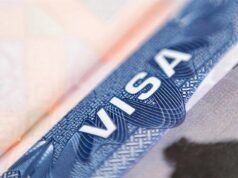President Donald Trump’s administration on Thursday published new visa rules aimed at restricting “birth tourism”, in which women travel to the United States to give birth so their children can have a coveted US passport.
Applicants will be denied tourist visas if they are determined by consular officers to be coming to the US primarily to give birth, according to the rules in the Federal Register. It is a bigger hurdle to overcome, proving they are travelling to the US because they have a medical need and not just because they want to give birth in the country.
Those with medical needs will be treated like other foreigners coming to the US for medical treatment and must prove they have the money to pay for it – including transportation and living expenses.
The practice of travelling to the US to give birth is fundamentally legal, although there are scattered cases of authorities arresting operators of so-called birth tourism agencies for visa fraud or tax evasion. And women are often honest about their intentions when applying for visas and even show signed contracts with doctors and hospitals.
The State Department “does not believe that visiting the United States for the primary purpose of obtaining US citizenship for a child, by giving birth in the United States – an activity commonly referred to as ‘birth tourism’ – is a legitimate activity for pleasure or of a recreational nature,” according to the new rules, which take effect Friday.
Trump’s administration has been restricting all forms of immigration, but Trump has been particularly plagued by the issue of birthright citizenship – anyone born in the US is considered a citizen, under the Constitution. The Republican president has railed against the practice and threatened to end it, but scholars and members of his administration have said it is not so easy to do.
Regulating tourist visas for pregnant women is one way to get at the issue, but it raises questions about how officers would determine whether a woman is pregnant to begin with and whether a woman could get turned away by border officers who suspect she may be, just by looking at her.
Consular officers do not have the right to ask during visa interviews whether a woman is pregnant or intends to become so. But they would still have to determine whether a visa applicant would be coming to the US primarily to give birth.
Critics say in addition to a rule that is hard to enforce, such restrictions unfairly target women.
“Pregnant women. This is administration is now targeting pregnant. women,” tweeted US Representative Alexandria Ocasio-Cortez. “When you single out the most vulnerable, the cruelty is the point.”
Actress and activist Alyssa Milano called the rules a “new low”.
“Just when you thought it couldn’t get any worse,” she tweeted. “This is a new low.”
Birth tourism is a lucrative business in both the US and abroad. Companies take out advertisements and charge up to $80,000 to facilitate the practice, offering hotel rooms and medical care. Many of the women travel from Russia and China to give birth in the US.
The US has been cracking down on the practice since before Trump took office.
“An entire ‘birth tourism’ industry has evolved to assist pregnant women from other countries to come to the United States to obtain US citizenship for their children by giving birth in the United States, and thereby entitle their children to the benefits of US citizenship,” according to the State Department rules.
There are no figures on how many foreign women travel to the US specifically to give birth. The Center for Immigration Studies, a group that advocates for stricter immigration laws, estimated that in 2012 about 36,000 foreign-born women gave birth in the US and then left the country.
“This rule will help eliminate the criminal activity associated with the birth tourism industry,” according to the rules. “The recent federal indictments describe birth tourism schemes in which foreign nationals applied for visitor visas to come to the United States and lied to consular officers about the duration of their trips, where they would stay, and their purpose of travel.”






























